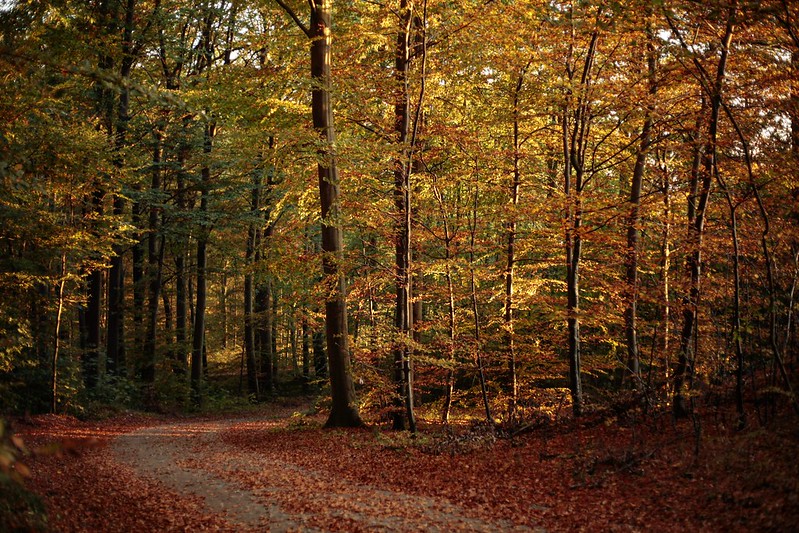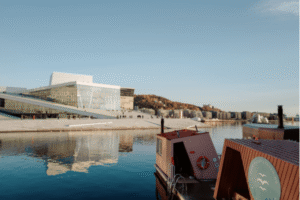Denmark may not have towering mountains, but don’t let that fool you, this country is a paradise for hikers. With over 7,000 kilometers of marked trails, Denmark offers a stunning mix of coastal paths, ancient forests, rolling heathlands, and historic pilgrimage routes. If you think it’s all just flat terrain, think again! Some trails will challenge your stamina, while others will immerse you in Viking history, medieval towns, and landscapes straight out of a fairy tale.
One of the best parts? You’re never too far from civilization. Unlike rugged wilderness hikes that require bear spray and survival skills, hiking in Denmark is a perfect blend of nature and accessibility. You can spend the morning trekking along dramatic cliffs and end your day with a Danish pastry and a cold Tuborg in a charming seaside town.
But with so many trails, where should you start? Whether you’re looking for coastal views, forest solitude, or historical routes, I’ve got you covered. Here’s a deep dive into Denmark’s top hiking trails, complete with practical tips, hidden gems, and everything you need to make your trek unforgettable.
Key Takeaways
1. Gendarmstien – Border-hugging trail of beaches, forests, and history. Certified one of Europe’s best for good reason.
2. Bornholm – Hike an island paradise of cliffs and coastal charm. 120km of views, villages, and serious Baltic hygge.
3. Vejle – A cross-country trek from sea to forested hills. Tides, valleys, and every landscape Denmark offers.
4. Amarmino – Urban escape meets nature walk. End your hike with wine in a fishing village just outside Copenhagen.
5. Møns Klint (Cliffs of Møn) – Towering chalk cliffs and wild nature. Feels like hiking through a Nordic dreamscape.
Situated along the Danish-German border, the Gendarmstien stretches over 84 kilometres of picturesque forests, beaches, and meadows. The trail has been certified as a ’Leading Quality Trail – Best of Europe’ by the European Rambler’s Association, guaranteeing a high-quality walking and sightseeing experience. Along the way, you can learn more about the history and culture of the South Jutland region of Denmark in towns like Dybbøl and Sønderborg.

Bornholm is a Danish island in the Baltic Sea off the south coast of Sweden. There are many ways to get there – car, plane or ferry – and the journey there is worth it. Bornholm’s spectacular scenery is the perfect background for a 120km hike along the coast. The coastal trail passes through quaint fishing villages, where you can spend the night and enjoy some Danish hygge.

This 130km long trail spans from the Wadden Sea National Park on the west coast to Vejle, a town on the east coast of Jutland, bustling with things to do and see. Experience all the landscape variety Jutland offers – from tidal flats and beaches to river valleys, hills, and forests.

The new 24-kilometre-long hiking trail Amarmino starts at the Ørestad neighbourhood of Copenhagen, takes you through the Amager Nature Park, and ends at a cosy fishing village Dragør, where you can enjoy a nice drink after a day of hiking. The hike is also relatively short, making it perfect for a one-day nature getaway.

Hiking Safety Tips in Denmark
Hiking in Denmark is generally safe, but preparation is key to ensuring a smooth experience. Here are some essential safety tips:
• Check the Weather Forecast: The Danish weather can change rapidly. Always check the forecast before heading out, especially during autumn and winter.
• Wear Appropriate Gear: Comfortable, waterproof hiking boots and layered clothing are essential. Even in summer, sudden rain showers are common.
• Stay on Marked Trails: Many trails in Denmark are well-marked, but veering off can lead to getting lost or disturbing protected areas.
• Inform Someone About Your Plans: If hiking alone, let someone know your route and estimated return time.
• Pack Essentials: Bring enough water, snacks, a power bank for your phone, and a basic first aid kit.
Environmental Considerations and Responsible Hiking
Denmark’s natural beauty is best enjoyed when we respect the environment. Follow these eco-friendly hiking practices:
• Follow the Leave No Trace Principles: Take all trash with you, including biodegradable waste, to preserve the trails.
• Respect Wildlife: Do not disturb animals, and keep a safe distance, especially in forests and coastal areas.
• Stay on Designated Paths: Straying from trails can damage fragile ecosystems and disturb local wildlife.
• Use Public Transportation or Carpool: Many trails are accessible by public transport, reducing your carbon footprint.
Understanding Danish Hiking Culture and Trail Etiquette
Hiking in Denmark comes with a strong sense of community and respect for nature. Keep these cultural insights in mind.
• Greet Fellow Hikers: A simple “hej” (hello) or a nod is common when passing others on trails.
• Dogs Must Be Leashed: If bringing a dog, ensure it is on a leash, especially in nature reserves.
• Wild Camping is Limited: While Denmark allows shelter camping in designated forest areas, wild camping is only permitted in specific places. Check local regulations beforehand.
• Cyclists and Walkers Share Some Paths: On mixed trails, be mindful of cyclists and step aside when necessary.
Accommodation and Facilities Near Denmark’s Hiking Trails
For those looking to extend their hiking trips, here are accommodation options near some of Denmark’s top trails:
• Mols Bjerge National Park: Stay at local guesthouses or eco-friendly lodges in Ebeltoft. Camping shelters are also available in the park.
• Camønoen (The Camino of Denmark): Bed & breakfasts and small inns along the route cater to hikers, providing luggage transport services.
• Hærvejen (The Ancient Road): Hostels and traditional Danish Kro (inns) are scattered along the route, offering cozy accommodations.
• Rebild Bakker National Park: Hotels and cottages are available in nearby Rebild and Aalborg, with camping options in the park.
For budget-friendly options, Denmark has shelter sites (primitive campsites) available for free or a small fee. Use sites like Ud i Naturen to find shelter locations.
Conclusion
By now, you’ve got a solid lineup of Denmark’s best hiking trails, from the wild beauty of Mols Bjerge to the legendary Camønoen, a Scandinavian take on the Camino de Santiago. Each trail offers something unique, whether it’s ancient Viking roads, endless coastline, or peaceful forests where you won’t hear anything but birdsong and your own footsteps.
But here’s the real takeaway: Denmark’s hiking culture is not just about the trails, it’s about the experience. It’s about stopping at a thatched-roof kro (inn) for a hearty meal. It’s about spotting red deer in the misty morning light. It’s about embracing the “hygge” of hiking, the feeling of comfort, connection, and simplicity that makes trekking through Denmark so special.
So, what’s next? Pick a trail. Lace up your boots. Grab a frøsnapper (Danish cinnamon twist) for the journey. And get moving. Denmark’s landscapes are waiting, and trust me, you won’t want to miss them.
And if you want to do a bit more than just hiking during your weekend in Copenhagen get some tips here, or perhaps a day trip?
Create A Custom Experience With Amitylux
If you plan a trip to Denmark and are interested in hiking – book a custom tour with Amitylux and let our knowledgeable guides show you the best hiking trails from an insider’s perspective.
FAQ
Yes! Denmark has 7,000+ km of trails, offering coastal routes, forests, and historic paths. Top hikes include Møns Klint, Camønoen, and Hærvejen. Well-marked and accessible, it’s great for all levels.
Norway for fjords and mountains, Sweden for Arctic wilderness, Denmark for coastal and historic trails, and Finlandfor forests and lakes. Norway is the most dramatic; Sweden is best for long treks.
Depends on your preference! Norway’s fjords, the Alps (Switzerland, France, Austria), Spain’s Camino de Santiago, and Scotland’s Highlands are top picks.
Yes! Dyrehaven, Amarminoen, and Hedeland offer great trails within 30–45 minutes of the city.




